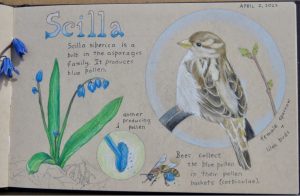
 By Liz Blaker
By Liz Blaker
Published in Arizona Daily Sun, July 11, 2022
I have always loved nature, but I only began to feel an intimate connection when I had to stay in one spot outside for hours, mostly alone, and found myself sketching.
I was a biology graduate student studying bumble bees. For my thesis I needed to capture bumble bee queens to photograph, mark, and release them. This meant I had to stake out a place with a lot of flowers and wait for the queens to show up. And wait. One day I noticed an orange and black bird with spots on its back singing and posing atop a manzanita bush.
His song was loud, jubilant, and challenging. His orange eyes blazed. Who was he, I wondered? I made a quick diagram in my field notebook to try to capture the notes and rhythms of his song. I tried to sketch him. Though my drawing was a disappointing scrawl, I had noted enough information to be able to find him in a field guide. He was a male Spotted Towhee.
I decided to learn to draw birds, animals, and plants so that I could record what I saw in a more satisfying way. I found a book on drawing birds by John Muir Laws and learned that my nature notes were what many people call a nature journal. Nature journaling is observing nature and recording what you see using words, drawings, and numbers. Journaling has been an essential tool of scientists for hundreds of years, from the famous notebooks of Leonardo da Vinci to the observations Charles Darwin recorded in journals. In recent years Laws has started and inspired nature journal clubs around the country, including one starting here in Flagstaff.
As a child, Laws was frustrated in school because of his dyslexia, but he enjoyed outings in nature with his parents. On one of these outings, his attention was captivated by watching a friend of his mother, who was sitting on the ground drawing a plant. He followed her all afternoon as she went from plant to plant, drawing each one. He just knew he had to do this. On the next outing his mother presented him with his own journal. From then on, Laws filled his journal with drawings of lizards, squirrels, whatever he saw that interested him, even robots and racecars. But it was the process of drawing outside that opened-up the natural world to him and drew him in.
Scientific studies have shown connecting with nature can improve our mental, emotional, and physical health. That’s a common experience for people who take time to sketch in nature. Long-time nature journaler, Fran Manos, found that journaling changed her.
“As I observe nature and record what I see, I have come to love our natural world as never before,” said Manos. “It’s infinitely complex, and we are part of it, along with the smallest gnat or the most fragile wildflower. Every time I look closely, I find something amazing! I love nature journaling; it has become a part of my everyday life.”
Nature journaling has become part of my life as well. Years have passed since I tried to draw the Spotted Towhee. I’ve learned that to make an accurate drawing, I must look closely and notice details. The more I look, the more the natural world opens to me and the deeper a connection I feel to nature, from dandelions to the stars in the night sky to my fellow human beings. As the poet Mary Oliver wrote, “Attention is the beginning of devotion.”
I want to help bring other people closer to nature, so I’m starting a Nature Journal Club. The first meeting is Saturday June 11 from 1:30 to 3:30 pm at the Museum of Northern Arizona Discovery Village. Nature journaling is a great activity for families, elders, teenagers – everyone. You don’t need to be able to draw. Just come see what this activity is all about and what it can do for you.
Liz Blaker is an artist and biologist who teaches nature sketching classes at the Museum of Northern Arizona Discovery Village. She is starting a Nature Journal Club, which will be free and open to all ages. Learn more here or email elizabethblaker1@gmail.com for more information.
